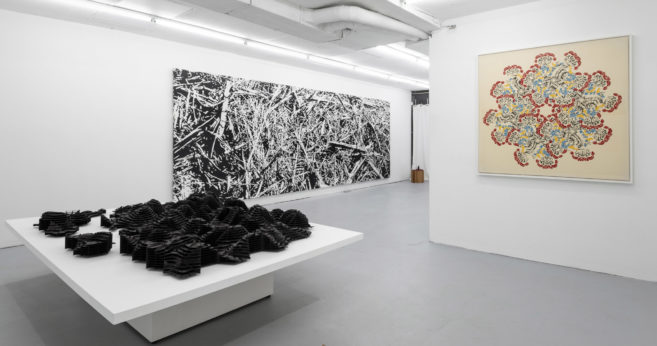Mandarin, English, Hindi, Spanish and Arabic are the most widely spoken languages in the world, and roughly in that order, but volume doesn’t necessarily correlate to visibility and power. “Second Tongues,” Serena Lee’s first solo exhibition in the UK, questions this uneven distribution of linguistic authority and reimagines a future where every single language that has ever existed, and the people who speak them, is granted equality.
Entering Cubitt’s one-room gallery, the viewer is met with a euphony of voices in a variety of accents and languages, emanating from the videos. Narrative fragments are scattered across the floor and walls, laid out like a giant multi-media scrapbook: images from vintage pedagogical fossil-discovery books are glued to the walls beside orange-tinted baked goods made from foam and salt-dough magnets made in workshops, and reams of scroll-like paper are draped over a pipe registering statements like “Would new forms of power emerge based on new forms of value?” Multicoloured foam mats (made by artist and designer Clemence Seilles at a foam off-cuts factory in France) are bound in rolls to create monolithic sculptural elements that double as squishy seating. The installation is Lee’s development of a speculative fiction, a proposal for a future where everyone is randomly assigned, at birth, a second language that they must learn alongside their mother tongue. The strength of the work is three videos that bring together the artist’s research from her long-term collaboration with groups such as The Voice of Domestic Workers and short-term “speed-dates” organized through a call-out for those interested, practically or theoretically, in how and why we learn languages. Together, the three moving-image works present a many-authored voice—combining backward scrolling texts, personal anecdotes and laughter montaged with animated salt-dough objects and images of cuneiform clay tablets, the earliest system of writing, predating Egyptian hieroglyphics. Augmented Reality (AR) elements, located with a map and seen through an iPad, accompany the videos, images and objects. The processes of discovery and translation AR demands of the viewer—to lean in and pay close attention, to listen carefully, to look for what might initially be invisible—importantly highlight one’s right to be heard regardless of the register.
An overt hierarchy of languages often determines who is valuable and visible and who is marginalized in society. One’s mother tongue is tethered to geographical and cultural specificities that can lead to discrimination based on race, accent, class, level of education and socioeconomic background. The artist’s desire to gain autonomy over the reduction of identity to language is poignant, particularly for some of the groups with whom she had conversations, including migrant workers and newcomer community-service providers.
An inherently plural category of thought experimentation, speculative fiction creates space for possible futures beyond a Western point of view, especially stories narrated from minority or alternative perspectives. “Second Tongues” proposes that learning replaces labour, cultural identity breaks down and power is decentered. Arguably one of the most important questions of the exhibition is posed by a critical voice at the end of one of the videos: “Who gains, who profits?” On one hand, if businesses could remove language barriers, market-driven globalization would certainly stand to gain, and to profit. On the other hand, through the artist’s dedicated collaborations, “Second Tongues” enacts and envisions meaningful bonds between people, producing a sense of community where cultural identity is more fluid and belonging can be conceived of on the scale of a nation-state. Lee puts her hands, and the hands of others, at the centre of the work with frequent clips in the videos of mixing, kneading, rolling and molding salt dough and the resulting objects made by members of The Voice of Domestic Workers. By presenting their hand-made salt dough pieces in the gallery, the physical labours of domestic workers: gardening, cleaning, cooking and caring are honoured as hand-held skills. Lee moves the language conversation away from soundless emojis and disembodied on-line translation tools and puts the emphasis on the polyvocal and sharing of knowledge.







